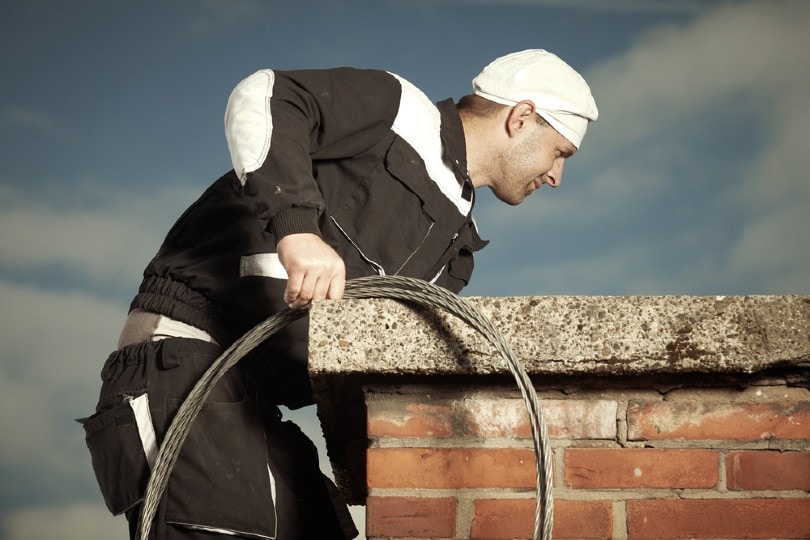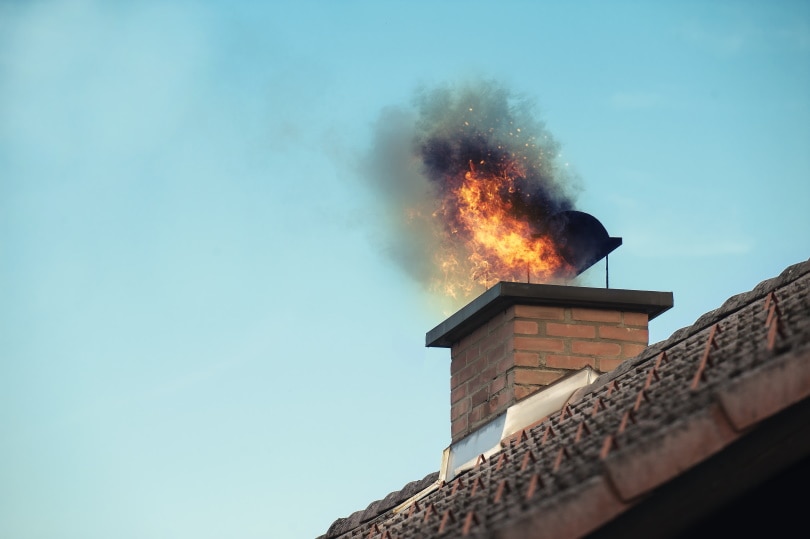How Often Should You Clean Your Chimney? Types, Signs, & Tips
-
Pete Ortiz
- Last updated:

Chimneys are vital safety devices specifically designed to prevent smoke and other toxic contaminants from filling up inside your home. Chimney cleaning may not seem like an integral maintenance task because the dirt build-up is not visually identifiable inside the chimney. However, it is an important maintenance aspect that shouldn’t be overlooked. You can avoid most of the repair issues in your home by regularly carrying out basic cleaning procedures.
Clearly, chimney cleaning will keep your home safe and sanitary, but how often should you clean it? According to the National Fire Protection Association, vents, fireplaces, and chimneys should be inspected and cleaned at least once every year for soundness, correct clearances, and freedom from deposits.
This article will discuss various aspects of chimney cleaning, including when you need a chimney inspection and how often you should clean it. We will also highlight the different chimney fire preventative measures to minimize the potential for fire in your home. Read on to find out more.
How Do You Determine Your Chimney Needs Cleaning?
Even though chimneys are designed to last for years, most homes still use wood and are susceptible to creosote build-up, which is a fire hazard. Also, even if a fireplace is rarely-used, rodents, dust, and debris from the outside environment can build up inside the chimney and clog the chimney vents. The debris will prevent the dangerous fumes from escaping into the environment, thus causing carbon dioxide poisoning in your home.
Before we find out how often you should clean your chimney, you first need to find out how extensive the build-up is. The chimney inspection process assesses the general condition of your chimney by scanning through all the basic components, including the stack.
So, when do you do a chimney inspection?
- Cleaning service experts recommend that you should have a chimney inspection done every year, especially if you use a fireplace regularly. Thoroughly check the fireplace, stove, furnace, and venting systems connected to them to ensure they maintain safe operations. You don’t want to risk the chances of an undiscovered issue turning into an expensive repair or, even worse, a chimney fire.
- If you have minimal use of your fireplace, a yearly inspection is still recommended. Check whether pests may have built up nests that could clog your chimney chamber or flue.
- Another great time to get your chimney inspected is if you recently upgraded or replaced the heating system. The inspection will ensure the chimney lining and venting systems are functional and adequate to handle the tweaks in the system.
- Several years of usage will cause deterioration of the chimney materials and eventually will require maintenance. The slow but gradual wear and tear of materials will affect the overall performance of your chimney system. Also, the longer the issues remain addressed, the more costly the repairs are likely to be.
The bottom line is that regular inspection of your chimney is not only smart and cost-effective but also the safest choice as well.

How Often to Clean the Chimney
There is no firm answer on the appropriate time to clean your chimney. Even though experts recommend that chimney sweeps are done after every year, an inspection by a reputable and experienced chimney inspector is the only sure way to know if your chimney needs cleaning, whether stone or metal.
It will also depend on how much you use your fireplace and the materials you burn to stay warm during cold seasons.
The 3 Types of Fireplaces
1. Wood Burning Fireplaces
There is nothing quite as enjoyable as lounging next to a wood-burning fireplace. You get treated to the pleasurable sounds, sights, warmth, and smells of a crackling fire. However, with long-time usage, you also get soot and creosote. It is a dangerous by-product of burning wood. Creosote is very flammable and can build up inside a chimney, reducing its efficiency at ventilating the house and causing a potential fire hazard.
So how often should one clean wood-burning chimneys?
- According to the Chimney Safety Institute of America, clean your chimneys if you notice at least 1/8 of sooty build-up inside the chimney and flue system. The creosote and soot can accumulate to high levels enough to fuel a chimney fire that can even spread to the house roof.
- Since most homeowners will not want to squeeze into the tight and murky chimney vents with a ruler to measure the soot thickness, a good rule of thumb is to have your fireplace inspected and cleaned every spring season.
- Therefore, if you go poking around your chimney and notice a glaze on the flue, consider scheduling an appointment with a reputable company for a chimney inspection and cleaning services.
The glaze is the flammable creosote that has accumulated on top of other creosote layers and dried up. Creosote layers form when the chimney is larger than the vent opening. This will create a sluggish draft when wet or unseasoned firewood is burned or when the draft control of an airtight appliance is set low. This will make the fire smolder and create soot. This creosote type is very difficult and time-consuming to remove and is a job best left to experienced chimney sweeps.
2. Gas Burning Fireplaces
Gas-burning fireplaces are a favorite option for many people because there is no wood to chop and haul. Furthermore, the fire ignites and extinguishes in seconds, and there are no ashes to sweep after warming up your living room. Yet, this does not mean that the chimneys from gas-operated fireplaces do not require regular cleaning to keep them operational.
Sure, gas is a clean-burning fuel, but after long usage, other problems will develop.
- Ceramic logs and clog vents can deteriorate, thus causing them to malfunction.
- The connections and the valves on the gas lines could also develop leaks creating a fire hazard.
- Thermopiles and thermocouples can accumulate dirt and debris, thus requiring cleaning.
- Moreover, if the exterior side of the chimney has a cracked crown or the motor joints are in a deplorable condition, moisture will leak into the chimney system, causing the flue tiles to break off.
Even if you use a gas-operated fireplace, an annual inspection is necessary to detect chimney issues before they pose a danger to you and your family.

3. Rarely-Used Fireplaces
Most homeowners often wonder whether it is necessary to have their seldom-used fireplaces cleaned and inspected. Yes, it is vital to have your chimney inspected even if the premises are rarely used. This is because unused chimneys offer appealing spots for birds, squirrels, and other small rodents to call home. The nests and debris they leave inside can limit ventilation when the fireplace is in use, possibly leading to carbon monoxide build-up in your home.
Furthermore, if you use gas-operated equipment such as a water heater or a furnace, you need a chimney for proper exhaust venting. The gas-operated equipment may not produce the black-colored soot, but they release other corrosive fumes which can damage the chimney without displaying any visible symptoms. Therefore, without regular inspection, you will not be able to determine if there is an underlying issue until the situation escalates, requiring expensive repairs.
If you suspect your chimney is playing host to all sorts of critters, have it inspected and cleaned every year, especially during late summer or early fall after the pests have raised their young ones and moved on. If you use your chimney for only venting gas appliances, contact a certified chimney cleaning expert to determine a cleaning schedule that works for you.
Chimney Fire Precautions
As earlier mentioned, creosote build-up in your chimney can cost you a pretty penny to remove, and it is a fire hazard. A common follow-up question usually is: “How can I maintain the safety of my chimney to avoid chimney fires?” According to NFPA, more than 30% of all house fires are chimney related. Failure to keep them clean is cited as the main cause of 30% of the cases.
There are several things that homeowners can do to avoid common chimney fires caused by the accumulation of flammable materials.
- Never let ashes gather in the firebox. When you can, empty the firebox when they start accumulating.
- Only use seasoned firewood in your fireplace. If you cut and gather the wood yourself, ensure it is seasoned for at least more than a year to remove any lingering moisture before burning. If you purchase from a local vendor, ensure that the wood is from a company that offers seasoned wood.
- Ensure the damper is always open before lighting a fire in the firebox.
- Never burn painted or pressure-treated wood in the fireplace. This tends to increase creosote buildup on pressure-treated wood and potentially create toxic fumes when burning painted wood.
- Pile the logs in the fireplace, starting with larger logs at the bottom, followed by the smaller ones. Also, add around one-inch kindling and a crushed newspaper. This method will get the fire started while preventing residue accumulation in your chimney. It will also allow the fire to burn hotter and with less smoke.
Conclusion
Chimneys are important safety features because they help reduce smoke and toxic gas build-up in our homes. Like any other home use equipment, the chimney system also requires regular maintenance to ensure optimum functionality. Failure to clean your chimneys will lead to the accumulation of toxic fumes, which can harm your body when inhaled.
Fortunately, you can get your chimney cleaned once every year, or at least get it inspected if you rarely use the fireplace. The goal of regular cleaning is to ensure the safe operation of the system without endangering your life. It’s also wise to check the chimney for nests or material build-up from pests and critters.
When warming up with wood-burning fireplaces, remember to use seasoned wood to reduce the extra repair costs of deteriorating chimney parts. Dry seasoned wood will also reduce the chances of creosote, which is the number one cause of fires in homes.
Featured Image Credit: Couperfield, Shutterstock
Contents



